The Inescapable, Indivisible Essence of Pottery
by Warren Frederick
Published in The Art of African Clay: Ancient and Historic African Ceramics, Douglas Dawson Gallery, Chicago Illinois, 2003.
How can objects created in earlier epochs, from our own or other cultures, touch us so deeply? Why is a double-necked water jar from the Mambila (Cameroon), a satin black Zulu ukhamba for brewing beer, or a softly bent-necked pouring bottle from the Matakam (Chad) so evocative? Can pottery whose origins spring from foreign cultures or distant times actually be germane today?
Pottery’s potency lies in its resolution of dual realities. There
is the obvious sphere of physical use: the realms of filling, pouring,
carrying, or perhaps brewing. Then there is the sphere of abstract use:
the metaphorical realms of sustenance offerings, status delineators,
emotional containers, or vital funerary accoutrements within a given
cosmology. For pottery this duality of abstract and physical use confers
both irreplaceability—no other medium can take its place—and
indivisibility—the utilitarian, spiritual, and aesthetic are forever
intertwined.
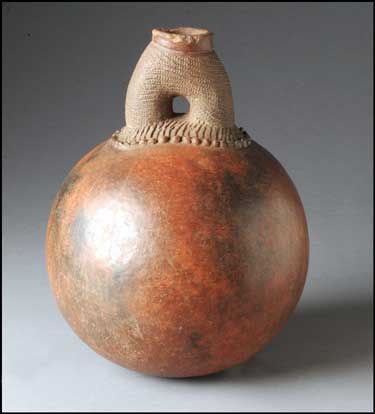
All photos are by Paul Lecat, copyright by Douglas Dawson.
Yet pottery’s essential utilitarian character can cloak the abstract essence through which these African vessels serve the soul. In Western cultures that have separated art from daily life, the seam of this duality is prone to being ripped apart. There are art historians whose perceptions are limited to pots as “merely physical containers,” anthropologists who treat pottery solely as data reflecting cultural interchange, even art critics who assess strictly in terms of purified formal aesthetic qualities such as color, volume or patterning. As in the ancient Indian parable, “The Blind Men and the Elephant,” all are exploring only one isolated aspect of a complex creation.
It is true that these objects cannot be experienced in their original
contexts. We are missing something by not carrying the day’s drink
in a Toussian water jar or by not storing an entire season’s grain
in a storage jar. Even exhaustive knowledge about a Cézanne distillation
of Mont Sainte-Victoire or a Jackson Pollack flung-pigment painting does
not permit our experience to match the artist’s. As objects leave
their place of origin—whether yesterday, one hundred, or five thousand
years ago—they begin to lose specific traits. It is forgotten who
made them, when they were made, how they were used. (fn
1) Even
if makers are known, as with documented self-taught or Art Brut artists,
their
conceptual
system still may be impenetrable. Yet the art remains extraordinary and
compelling. (fn 2) We seem destined to stitch
together glimpses of each story; we learn about other times and places;
we interweave
our own immediate,
personal, and vibrant relationships. Art is always moving away from its
origins, suffering an inevitable loss of context. However, beneficially,
the accretion of time permits related objects to be newly grouped, bridging
time and geography. Delineations of excellence evolve, but current masterpieces
are never mute. The eloquence of the hands, eyes, and hearts that made
these objects still captures our passion.
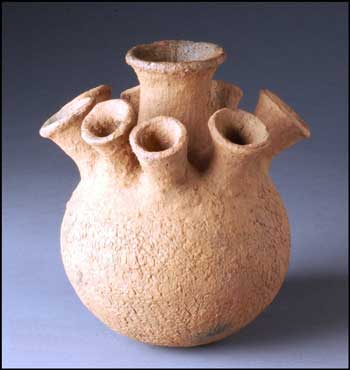
Ewe (Ghana or Togo) H 8.5" x W 5.5"
If
forced to generalize, I would argue that these stunning African objects
convey a fundamental sense of earthiness and immediacy. This pottery
embodies nature as it also manipulates nature. The unadorned qualities
of clay and earth are embraced in these pots. As a material deftly
handled, earthenware is less prone to the afflictions that can overwhelm
higher-fired clays concealed with thick, colored, and seductive glazes.
Incorporated in these African vessels is a unified spirit of spontaneity
and assurance, whether rough and unrefined or elegant and vigorous.
Early art that is articulate speaks to us because it is attuned to current necessities. Our common humanity explains both our need and our ability to draw insights from the creations of others. No matter how dispersed the origins, objects coalesce as pertinent answers to perennial, duplicative questions. In 1962 George Kubler, an anthropological art historian, adroitly analyzed the history of ideas and art objects in his seminal book, The Shape of Time. Replacing progressive and linear theories of stylistic change, Kubler argued that an art object “points to the existence of some problem to which there have been other solutions and that other solutions to this same problem will most likely be invented to follow the one now in view.” (fn 3) For Kubler, objects are reinvented resolutions to enduring problems. For artists—whether potters or painters—the modern configuration of tradition embraces objects clustered closely in meaning but diverse in material, cultural, and temporal origins.
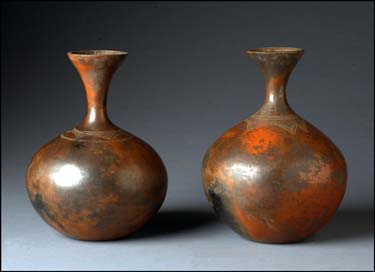
Tutsi, Rwanda H 9" x W 6" and 6.5"
This dynamic grouping is legitimate because human character and biology
change far more slowly—if at all—than do technology or economics.
We are far closer to our historical or foreign brethren than we usually
imagine. We share a remembrance of our common destiny of death, our equivalent
senses of hunger and satiation, and our inescapable emotions of joy and
sorrow. Pottery flourishes among these existential facts. Art in all
its manifestations exists as an essential mediator of existence. (fn
4)
There is a common mistaken belief that artistic endeavors demonstrate
progress, perhaps because we are so used to witnessing technology advance.
Yet if art truly progressed like technology, then today’s art objects
would clearly outshine everything in our museums. Incontrovertibly, they
do not. Kubler’s perspective is corrective. One chain of solutions
in relation to another coherent chain is not inherently progressive or
sequential. The closer we examine a sequence of vessels, the more unique
each becomes, neither explaining what came before nor predicting works
yet to come.
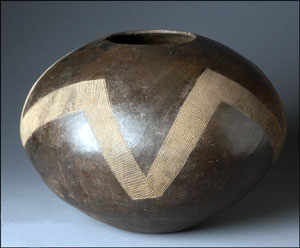
Zulu H 15" x W 19"
At first, all Zulu beer fermentation jars seem stylistically similar. But in fact, they differ by maker and by user. (fn 5) All potters know that the manners in which they handle the clay—their personal signatures—are almost impossible (and undesirable) to erase. When first made, each Zulu jar expressed accepted norms, regional variations, and, I would argue, recognizable individual aesthetic innovations. The patterns of amasumpa (raised pellets), probably a royal prerogative, once expressed other specificities that are forever lost. Yet, as handmade artistic objects, each vessel remains unique and alive. Kubler compares style to a rainbow: once we reach the source it disappears. (fn 6) Vessels are not transparent windows into the past, but membranes that express their own properties and qualities. For an artist, historical pots are a contemporary reservoir of inspiration. They enlarge the vocabulary of a common ceramic language and enable new methods of combination and communication.
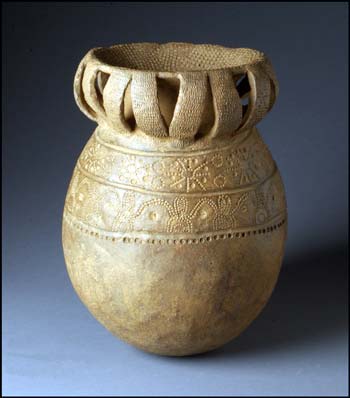
Nyonyosi-Yatenga, Burkina Faso H 15" x W 11"
Appreciation is not simply a matter of aesthetic intuition, though intuition is an essential sensibility. Comprehension is also an accretive educational process of connoisseurship. Determining virtuosity partly emanates from comparisons and references within the universe of known clay vessels. What carries forth my passion in these African pots is a ricocheting energy between each vessel’s overall aura and the nuances of inventive phrases freshly spoken. Densely handled rims, textured and whorled patterns, and sculptural necks are all fecund, provoking dreams and gestations of new recombinations within personal motifs.
Tasting the essence of pottery requires memory excavations; retrievals
of patterns formed by using and seeing countless other objects, man-made
and natural. (fn 7) Elements are not necessarily
harmonized, as in discordant but emotive music. Disentangling may begin,
perhaps, with the clay’s
character. Textural impurities in these African pots impart an assertive
sense of directness, an emotional acceptance of earth. Vessels in this
exhibit with more purified clays bespeak elegance; material refinement
elevates emotional distance. An enclosed volume may be bursting or focused,
the upward visual thrust—from a base or a higher area of transition—forcible
or subdued. Where the fullest point of a form is positioned contributes
to impressions of stolidness or loftiness. The neck’s resolution
of the pot’s shoulder may be abrupt and exaggerated or fluid and
graceful. Texture, color, the sensitiveness of stance (base or foot),
and so forth all contribute meaning. In an eloquent vessel, all of these
facets work in conjunction, admirably tensioned. The parts compose the
whole but do not explain it. Creating a living pot demands personality
rather than consistency or reassurance. For instance, refinement contrasted
with irregular yet decisive handling speaks more potently than overall
precision that obliterates traces of the potter’s presence.
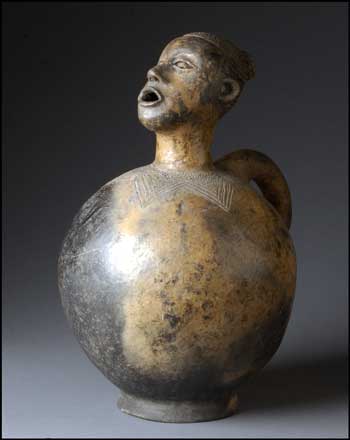
Luba H 18" x W 11"
Arthur Lane’s slim 1948 book, Style in Pottery, reflects useful
common discourse: “In using such words as lip, neck, shoulder,
belly to describe the shape of a pot we acknowledge its likeness to a
living thing.” (fn 8) Pots reflect not only
universal human character traits—anguish as well as vigor—but
also the diverse shapes and protrusions of the human body. This is not
false anthropomorphism,
but a primary instance of pottery’s unique abstracting capacity.
As a metaphor for the human body and as an object typically sized to
fit the embrace of our hands, pottery is a close, manipulable presence.
These attributes confer irreplaceability. They set pottery apart from—but
not below—untouchable, monumentally sized art, such as paintings
that only fit museum-sized walls. Yet even with such generalizations
by genre, approachability varies.

Cameroon H 18" x W 15"
Many vessels in this exhibition manifest intimacy as a heightened, palpable
quality. Mounded earthenware firings that maintain the visibility of
the hand-forming methods used and that magnify the clay’s physical
tangibility intensify intimacy. A closer insistent presence also derives,
at times, from unexpectedness—an unanticipated double neck, an
unusual shaping of a shoulder or foot, looped handles that seize exterior
volume, or a convoluted yet coherent patterning. Touch is inescapably
vital for experiencing all pottery because of the centrality of its use.
Yet this pottery seems to additionally beckon, to demand even more intensive
contact when conveying heretofore-unseen expressive constellations. Touch
unlocks nonvisual dimensions: heft, warmth, or the wet evaporative seepage
of an earthenware water jar. Turning a pot in our hands creates tactile
sensations of three-dimensional rhythms, the syncopation of irregularity
in form. Full creative encounters entail repeated but nonduplicative
use. Interaction transforms both the object and us.
I have previously written about the poetics of primitive pottery, the
value of vigorous and spiritual art, but no matter how it is explained,
primitive negatively connotes simpleness and backwardness emanating from
cultural arrogance. (fn 9) It is our ignorance
of the abstract sphere of pottery that is unsophisticated, not the objects
themselves. To take one example,
surface patterning is simply not superficial. So-called ornamentation
is not an addition or an afterthought, but an indivisible component of
completion and fulfillment. (fn 10) Perhaps if
we conceptualize pottery surface as skin we can convey the essentialness
of surface markings. Skin is
indispensable to life, the central mediator between our internal nature
and the external natural environment. Treatments to each vessel’s
skin are integral to these forms. Even when symbolically unfathomable,
these clay skins are reminiscent of body markings, wood carvings, textiles,
braided ropes, and animate creatures.
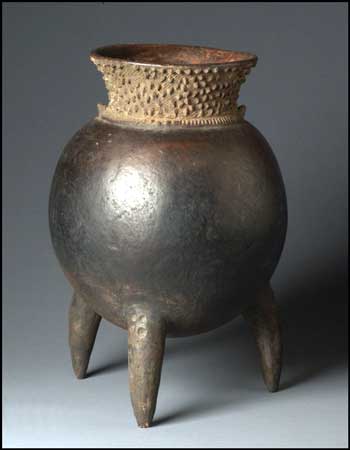
Kirdi/Chamba H 22" x W 14"
Significant pottery reveals an extraordinary rapport of form and surface
image. What is admirable about these African vessels is not the result
of a particular technical flourish, stylistic rarity, technological
accomplishment, or royal provenance. Esteem is due to an intense
expressiveness of material
and usability. The ineffable is real but not fully describable. The
physical-cum-abstract use of pottery is ongoing. Historical objects
and freshly made art can
be equally potent. Neither can be fully eloquent in isolation. Part
of the past is modern and alive. Part of the modern partakes of the
past.
Pottery, inescapable and indivisible, new and old, deepens perception
and enlarges imagination.
Notes:
1. We should never replace our ignorance as to the utilitarian-aesthetic-symbolic life of an object with the belief that no such complex creative nexus exists. Nor should we mistake our inability to discern who actually made an object with the assumption that the object was anonymously generated. We should recognize the speciousness of any claim that the genesis of another culture’s material objects does not involve any individually chosen aesthetic decisions. Recent scholarship has begun to correct for these myopic views, documenting in Africa, for instance, the wide creative latitude exercised by specific individual makers creating within sophisticated cultural traditions and needs. See for instance, Sally Price, Primitive Art in Civilized Places (Chicago: University of Chicago Press, 1989), particularly chapters 4 and 8.
2.For an evolutionary explanation as to why we fundamentally
respond to “outsider” art—or any art, including pottery—see
Ellen Dissanayke, “Very Like Art: Self-Taught Art from an Ethological
Perspective,” in Self-Taught Art: The Cultural and Aesthetics
of American Vernacular Art ed. Charles Russell (Jackson: University Press
of Mississippi, 2001), 35-46.
3. George Kubler, The Shape of Time: Remarks on the History
of Things (New Haven: Yale University Press, 1962), 33.
4. Ellen Dissanayake, Homo Aestheticus: Where Art Comes From
and Why (New York: The Free Press, 1992).
5. Frank Jolles, “Zulu Beer Vessels,” in Tracing the Rainbow: Art and Life in Southern Africa, ed. Stefan Eisenhofer (Stuttgart: Arnoldsche) 306-319.
6. Kubler, 129-130. Also see Kubler’s introductory comments on the history of art and the place of the artist in The Art and Architecture of Ancient America, 3rd ed. (New Haven: Yale University Press, 1990), 37-45.
7. Philip Rawson’s treatise, Ceramics, the only in-depth inquiry in English to delve into pottery’s aesthetic grammar, explores the symbolism of the many physical aspects that compose a vessel. Philip Rawson, Ceramics (London: Oxford University Press, 1971).
8. Arthur Lane, Style in Pottery (London: Oxford University Press, 1948), 10.
9. Warren Frederick, “The Poetics of Primitive Pottery,” in Ceramics: Art and Perception, 20 (1995), 43-45.
10. Rawson for instance, notes that “we have to make the effort imaginatively to put ourselves in the place of the users, seeing the symbols as having not the content we might see in them…but as elements in a vivid life of sensation and emotion.” All patterns “must have been meant…to add value and spiritual effectiveness, through their evocative overtones, to the ware in the eyes of its user” (161, 165).
Cesar Paternosto,
an abstract painter and sculptor, has clearly and extensively argued
that for many
non-European material objects (fiber,
clay, stone, wood, or metal) surface patterning itself is the central
art. Paternosto’s specific convincing example is for the centrality
of geometrically patterned Andean textiles as that culture’s primary
and most essential symbolic language. He also explores these textiles’ direct
influence on 20th century artists such as Paul Klee, Adolph Gottlieb,
and Barnett Newman. Cesar Paternosto, Abstraction: The Amerindian
Paradigm (Brussels: Societe des Expositions du Palis des
Beaux-Arts de Bruxelles, 2001).